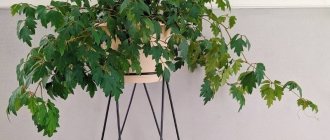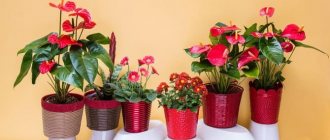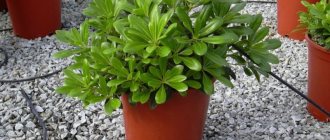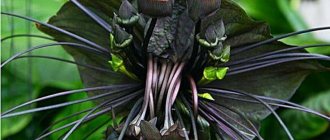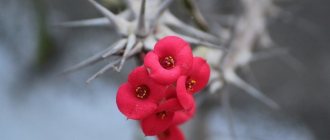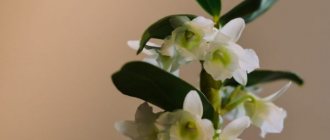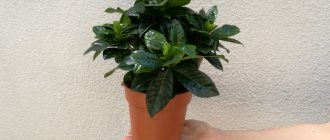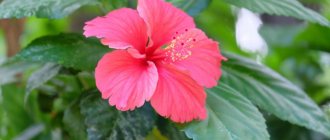While office gardening is becoming increasingly popular and an important element in creating a comfortable workspace, growing indoor plants at home remains somewhat of a taboo for many. The modern world with its pace does not leave much time for hobbies, and the fear of destroying plants haunts many who have not yet personally encountered growing them. But, believe me, even without experience and special time for basic procedures, you can achieve success and enliven the atmosphere of your home with living plants. After all, there are some indoor plants that you still have to try hard to destroy. Both beginners and anxious owners can easily cope with the most reliable types.
Criteria for choosing indoor plants for beginners
If you need to find a houseplant that a beginner will definitely not have any problems with, you need to look first for its practical characteristics, and only then for its decorative properties and your own taste.
Characteristics that you should pay attention to first:
- thermophilic and undemanding to temperature, including during wintering;
- ability to adapt to different lighting;
- drought resistance and insensitivity to interruptions in watering;
- ease of recharge;
- resistance to dry air;
- the ability to quickly recover from damage, ease of rejuvenation and formation.
There is one more little secret: problems rarely arise with plants that can be grown both in substrate and hydroponically.
It is on these principles that our top ten “problem-free” plants are formed.
Related article:
An unusual flower for the home without any problems: I fell in love with it in 2018!
Aloe vera
This is one of the most famous plants, which is famous for its medicinal properties. Aloe juice helps soothe the skin after burns or eczema.
That is why it is recommended to keep this plant in your kitchen. Aloe will do double duty: bring a little greenery into the interior and act as a natural first aid kit. You can also make various nourishing cosmetic masks from the gel or add it to creams.
Rare 20,000-year-old Paleolithic blade found in China
The Home Cleaning Basket and Other Simple Time-Saving Tricks
Juicy roll made from simple ingredients: potatoes, cheese and ham
Chlorophytum
Chlorophytum comosum is more relevant today than ever. From the lush rosette, amazing shoots grow in arcs with inflorescences of delicate flowers at the ends, quickly changing into small rosettes with aerial roots. Chlorophytums form real cascades. Bright green or striped, they always look fresh and cheerful.
Chlorophytums grow well in bright light and in the shade, in any room, and forgive skipping procedures. The main thing is not to overcool the plant and not forget about it forever. And the speed of growth and ease of reproduction in them is the envy of all other indoor plants.
Chlorophytum comosum
Easy to care for ground cover flowers
If you are pursuing the goal of creating a flower carpet rather than a flower bed, then you should pay attention to low-growing plants that creep along the ground.
Phlox awl-shaped
This perennial groundcover can transform a dull lawn into a riot of color: just plant several varieties nearby that differ in the shade of the inflorescences. The plant will quickly spread and will become an excellent frame for flower beds, mixborders or paths.
Dianthus
Herbaceous, beautifully flowering, creeping plant. Lives for many years ; small bright crimson flowers are visible from afar and attract attention to the flowerbed where the plant is planted. Externally, the jacket resembles a small fluffy mound.
creeping thyme
A medicinal plant and herb , thyme not only serves practical purposes, but also makes an excellent ground cover. Its thick, dense carpet exudes a pleasant aroma, and the small pinkish flowers look very neat.
Periwinkle
An indispensable plant when it comes to framing shaded flower beds, rockeries and borders. Periwinkle is extremely unpretentious; In spring it is covered with sky-blue fragile flowers.
A “lazy” flower garden is not a gardening myth at all ; it is quite possible to create it in your dacha. Before you breathe out a sigh of relief, you just need to work a little and think carefully about where to arrange the flowerbed and what plants to plant. All in your hands!
- Author: Maria Sukhorukikh
Rate this article:
- 5
- 4
- 3
- 2
- 1
(0 votes, average: 0 out of 5)
Share with your friends!
Ficus
The huge genus of ficus allows you to choose plants according to your taste and interior. Any classic ficus is a reliable houseplant, and two varieties are especially loved for their unpretentiousness:
- Benjamin's ficus (Ficus benjamina) - bush or tree-like plants with a dense crown of thin branches and dense, shiny, ovate-lanceolate leaves with a simple or variegated color;
- rubber ficus (Ficus elastica) is a powerful vine with aerial roots and very large oval shiny leaves.
These ficus grow well in both sun and partial shade, they love warmth and standard care - fertilizing in spring and summer, watering after the top layer of soil dries and regularly wiping the leaves from dust.
Ficus benjamina
Ficus elastica
Spathiphyllum (female happiness)
Spathiphyllum is popularly called “female happiness.” It is believed that if the plant grows actively and blooms profusely, then the woman in the house is happy. This is, of course, prejudice. Spathiphyllum is loved by gardeners because its flowers resemble calla lilies. The flower is shade-tolerant, does not like direct sun and excessive waterlogging.
Blooms actively all year round. When replanting a plant, you need to choose the right pot. If it is small, the plant will begin to squeeze out the soil, and if it is large, this will lead to the root system actively growing, while the above-ground part will be stunted, stunted and with small flowers. Choose a pot so that it is slightly larger than the main ball of earth intertwined with roots.
Spathiphyllum humidifies the air in the room. Adds a touch of aesthetics and comfort to your home interior.
Dieffenbachia
Dieffenbachia is ruffled, bright and at the same time simple, it captivates with the play of cream, yellow and white with a bright green color of ovoid leaves that unfold from tubes. And luxurious new varieties that bush well and create low, attractive forms rather than stretching to the ceiling are becoming increasingly popular.
Dieffenbachias do not like the cold, but they can tolerate complete drying out of the soil and occasional overwatering. If you place them in a protected place and in good light, and occasionally add universal fertilizer when watering, there will be no problems. And pruning and re-rooting will easily return the plant to its shape.
Dieffenbachia
Ivy
This is a beautiful climbing plant that, if it finds the right support to properly cling to, will twine around it completely. This is an evergreen flower that looks good when several specimens are arranged together.
You can combine 2-3 pots with ivy and hang them on a hill. This will help create elegant green rugs. Ivy is an excellent choice for visually dividing space. It will also fit well into the interior of the kitchen for its landscaping.
Blue or yellow: how to calculate your interior color by date of birth
Not a warehouse, but a place to relax: how to decorate a balcony on a minimal budget
An investigation by Samara local historians confirms: “Zoya’s Standing” is a legend
Sansevieria
Sansevieria is an unpretentious queen that looks at us from the dark corners of rooms. Sansevieria are real Spartans for both the office and the home, able to withstand anything except dampness. Luxurious stiff leaves in neat rosettes of honey , long straight sword-shaped leaves with a variegated “mother-in-law’s tongue” , similar to sculptures, thick shoots of Sansevieri and cylindrical combine durability and endurance.
Sansevieria can withstand everything: underwatering, drought, dry air, shade. They forgive mistakes in watering and lack of fertilizing. If you don’t overwater the plants and keep the leaves clean, the “pikes” will be fine.
We have a detailed article with descriptions, varieties and types of Sansevieria
Sansevieria
Crassula ovalum (Crassula oval)
Many people know this plant under the name “money tree”. People who believe in omens and good luck definitely keep such a plant at home. The shape resembles a tree, and the leaves resemble coins. Hence the name. The plant does not bloom in potted conditions. Care requires a sufficient amount of light, since the Crassula is light-loving, moderate moistening of the earth clod and moderate air humidity. When the soil becomes waterlogged, the leaves of the fat plant swell and burst, and the process of rotting begins under the influence of bacteria. As a result, the plant may die.
Dracaena
Dracaena is the queen of indoor palms, but in reality it is just a pseudopalm. And the appearance with a bunch of delicate thin leaves above a lignified trunk is so palm-shaped that few people care about the nuances of classification. At first compact, dracaenas gradually rise and become bare below. There are varieties with thinner or wider leaves, plain or with stripes and valances, and all dracaenas look exquisite.
Dracaenas grow well in a light shaded place and require warmth and ventilation. If you avoid overfilling, there shouldn't be any problems. Even if the dracaena stretches to the ceiling and loses its decorative effect, it can be easily re-rooted or trimmed.
Dracaena: types, cultivation features
Dracaena
Aspidistra
This is simply an ideal plant for all beginning gardeners. It can grow in absolutely any corner, wherever you place it. Aspidistra is usually not susceptible to pests.
In addition, it is simply ideal for rooms with insufficient lighting, such as corridors and halls, since it is better not to be exposed to direct sunlight. For a more whimsical effect, you can trim off a few leaves.
Haworthia
Haworthia is one of the most fashionable plants for arranging florariums and succulent compositions. This indoor plant is equally decorative and unpretentious. Rosettes of fleshy, pointed leaves with jagged edges and light growths look miniature and neat. And the ability to grow in colonies only emphasizes the beauty of this modest, but very rich variety and variety of plant.
Haworthias love bright light and only dislike one thing - waterlogging. They are able to withstand any drought. If you adhere to the rule of minimal watering and do not overdo it with fertilizing, Haworthia will become one of your favorite indoor crops.
Haworthia
cacti
cactus (Cactus) is suitable for the title of a plant that will be content with minimal care from large prickly pears to cereus and mammillaria, with the exception of flowering species. Armed with huge spines or spines - miniature, thick, long, straight or hooked - cacti offer a huge selection. The actual root plants with varying degrees of pubescence can also be grafted. The shape of the stem is from round to cylindrical or oval. Ability to develop - in colonies or single plants. Cacti can even have different colors, often artificial and bright.
To avoid problems with cacti, it is worth remembering only one thing: excess water should not be allowed. Water them with a really minimal amount of water no more than once a week. They need special soil and fertilizers for succulents.
Cacti (Cactus)
Kalanchoe
The well-known Kalanchoe with babies on the edges of the leaves has a medicinal effect. Kalanchoe juice is very good for coping with a runny nose. It is enough to drop a few drops into each nostril - and active sneezing begins, which clears the airways. The juice also has bactericidal properties.
Currently, there are a huge variety of beautifully flowering varieties of Kalanchoe. Flowers come in a wide variety of shapes and shades. This plant can bloom all year round.
Like all succulents, Kalanchoe loves a lot of light. Watering should be moderate. The plant is unpretentious to the soil, but it is good to replant it once a year. It is advisable to do this in early spring and late autumn. It is necessary to choose the moment when flowering stops. Carefully cut off the inflorescences. After this, the plant may be sick for a short time. As soon as the vegetation is restored, it is necessary to replant.
Lithops and other “living stones”
Miniature, more like pebbles, Lithops and Co. are unique plants. These are supersucculents in which the stone-like body is formed by two thickened leaves with a slit. After a cool winter, they are able to surprise with luxurious bright flowers. You can watch the change of “generations”, the growth of replacing pairs of leaves on a “living stone” endlessly.
Lithops and other types of “living stones” differ little from cacti. Without a cool winter, they do not bloom, and care is reduced to minimal watering and a few feedings of these indoor plants.
Lithops
Planting flowers in flowerbeds and containers
A composition of regular geometric shape - in the form of a circle, square, polygon - is usually intended for all-round viewing. Flowerbeds are placed in the front parts of the garden, for example at the entrance to the house. Therefore, it is important that they attract attention throughout the season.
For planting plants in the garden in a flower bed, preference is usually given to summer flowers that bloom from spring to autumn, sometimes changing the composition: until June 10-15, the flower garden is decorated with bulbs planted in the fall or viola, which is planted in mid-May.
These plants are not afraid of spring frosts. At the beginning of summer, cold-resistant flowers are replaced by heat-loving summer flowers, and flowering continues until autumn.
Containers are used where it is impossible to create permanent flower beds - in areas with hard surfaces, on balconies.
This is a very practical idea for planting flowers to decorate a plot, allowing you to create mobile compositions and change the appearance of the garden at the owner’s discretion. Not all plants are suitable for such plantings.
First of all, we need drought-resistant crops - the soil in a container dries out much faster than in a traditional flower garden. Plants with wide leaves that consume a lot of moisture are not suitable for such plantings. The best choice is compact plants or their varieties that have a beautiful shape—spherical, pillow-shaped, or ampelous.
As shown in the photo, when planting garden flowers in a massive container, you can place a fairly large and “ankle-legged” plant in the center, decorating its lower part with a “skirt” of lush summer flowers:
What to do if you want to get a beautiful front garden on your summer cottage, but you don’t have the time or energy to care for it? The article is devoted to describing the most popular crops among “lazy” gardeners. Have a hassle-free summer!
Homemade violets
Tiny Saintpaulias , charming neat bouquets with velvety leaves and delicate shining flowers, have become indoor classics for good reason. Fragile, fleshy, neat in everything, they surprise with their perfect beauty and variety of varieties. Growing Saintpaulias is very simple, although the approach must be special, unlike caring for other unpretentious indoor plants.
The best nutrition for violets for flowering with a cap
To avoid difficulties with Saintpaulias, it is better to water them not along the edge, but using the bottom watering method. The leaves and base of the rosette should not be splashed. Saintpaulias do not need spraying or frequent feeding with special fertilizers. If you replant the bushes every six months, as most fans of the plant prefer, then you can skip fertilizers altogether.
Saintpaulia
How to create a flowerbed of continuous flowering?
The effect of continuous flowering can be achieved by planting annual and perennial flowers at the same time. In this case, flowering will be ensured from April-May until the first frost.
Perennial plants have a number of benefits. This is a one-time planting, easy care, easy replanting, adaptation to living conditions, frost resistance.
Among the perennial plants that take root well in the flowerbed are irises and lupine, picky Turkish carnation, lychnis, foxglove, eschscholzia, dahlias, gladioli, lilies, echinacea, cornflower, crocuses, hyacinths, astilbe, gaillardia, tulips, muscari, hazel grouse, bergenia, pushkinia, hellebores , iris, daylily, heuchera, daffodils, scilla, chionodox, fern, hosta, peony. Remember that gladioli and dahlias should be dug up for the winter, because... they are afraid of severe frosts. The remaining plants do not require replanting.
27 unpretentious flowers for floriculture in the country
To make a garden plot beautiful, beginning gardeners invest a lot of effort, money and time into creating original flower beds. Most people dream of decorating their summer cottage with unpretentious plant species that are not demanding on watering, care, and climate, but not everyone succeeds the first time. You can choose the right flowers by studying floriculture at your dacha, taking into account the location of the site and the seasonal decorativeness of the desired flower garden.
Among the bulbous plants, the most loved by gardeners are:
- Iridodictiums;
- muscari;
- daffodils;
- botanical tulips;
- Chionodoxa;
- Colchicum;
- crocuses;
- Pushkinia
More experienced flower growers advise planting garden flower beds with beautiful flowering perennials, including:
By choosing flowers of different colors, having different flowering periods and textures, you can create an original flower garden from the astilbes themselves. You can learn more about the nuances of planting and caring for astilbes by reading articles on the topic “Floriculture in the country for beginners.”
- loosestrife;
- periwinkle;
- meadowsweet;
- evening primrose;
- perennial cornflower;
- swimsuit;
- geranium;
- small petal;
- doronicum;
- Brunner;
- purchased;
- spurge;
- lupine;
- lungwort;
- goldenrod;
- catnip
Very loved by gardeners for their unpretentiousness, simplicity and care in growing such annual and biennial flowers as:
- forget-me-nots;
- calendula;
- viola;
- phacelia;
- linen;
- marigold;
- cornflowers;
- Turkish cloves;
- daisies;
- nasturtium.
As you can see, there are quite a lot of plants designed to create beautiful flower beds in summer cottages. The list of plants can be supplemented with more and more new types of flowers. The whole difficulty lies only in the desire to create something beautiful and unique, the effort and time put in.
Floriculture for beginners (video)
To choose one or another method of planting garden plants, you will not only have to look at beautiful illustrations in specialized catalogs, but also learn about the features of forming landscape groups. To plant flowers in the garden as your imagination dictates, good taste is not enough.
It is necessary to follow the rules of compatibility, because some crops can suppress others or bloom at the same time, and for the rest of the time your plot will seem empty.
Even beautiful and well-groomed plants, chosen in accordance with the natural conditions of the site, will not make a good impression if they are planted in disarray, without taking into account the decorative features of each species.
There are several basic ways of planting flowers, and for each type of composition, plants are selected in a special way. The height, shape, flowering time, and development during the summer season are taken into account.
You will learn how to plant flowers in the garden correctly and beautifully by reading this material.
Swamp Papyrus
Smikavets , Cyperus or, simply, indoor papyrus - the plant is indeed the closest relative of the main culture of ancient Egypt. Thin hollow stems are carried at the top of an umbrella-whorl of grass-like leaves to a height of up to 2 m, creating rustling fragile shrubs in miniature. Elegant, simple and very airy, Cyperus always looks bright.
For gardeners who like to overwater indoor plants, this is a real find. Cyperus requires one thing - protection from drying out of the earth. Constant “swamp” humidity is easily controlled by the weight of the pot and by touch. This plant will not suffer even without feeding! And if suddenly you are away for a long time and the papyrus turns yellow, you can completely cut it off and within a week or two new umbrellas will restore the beauty of the turf.
Cyperus

